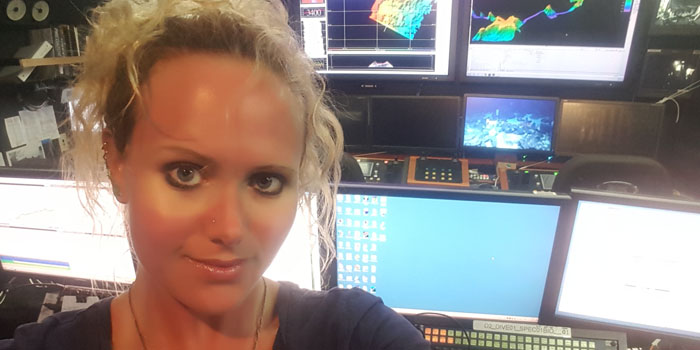
Meet Breezy Grenier
Read the full text of Breezy's interview below to learn more about her experiences.
About Breezy's Role
What were your duties as an Explorer-in-Training? Where was your work experience located?
I was a mapping watchstander while aboard the Okeanos Explorer. Our expedition began in Kwajalein, Marshall Islands and ended in Guam, Northern Mariana Islands. Our mission was to explore and map the deep-water regions surrounding Wake Island in the Pacific Remote Islands Marine National Monument, now known as Pacific Islands Heritage Marine National Monument.
If you were working at sea, what were your impressions of living and working on a ship?
Living aboard a ship is nothing new to me being a Coast Guard veteran. I have sailed around the Antarctic Peninsula and Scotia Arc with the Geological Society of America, and am a SEA Semester’s Global Ocean Program alumni, where I sailed around New Zealand. From boat deliveries to working on fishing vessels, I have put on many miles at sea, but the experience of living and working aboard a research vessel was nothing like I had originally expected. I was not expecting a “9-5 schedule” while at sea. I am used to rotating watch schedules, on top of a daily work schedule, but here I worked every day from 3:30 pm to 11:30pm ship's time. To make it a little crazy, I was recording times and dates in both ship's time and UTC, luckily it was a 12-hour difference which made the math easy! My tasks included recording sunlight readings every 2 hours, sound velocity readings every 6 hours, and monitoring the constant acquisition and processing of multibeam, EK60, and sub-bottom data. Processing the multibeam data also consists of backscatter, water column analysis, and bathymetry. The only thing I was truly used to regarding “the typical life at sea” was staring out into the ocean where it seems like you're staring out into an endless mirror, the sunrises and sunsets engulfing not only the sky but the ocean as well, or the nights where the bioluminescence lit up a trail following the ship, and as you look up into the sky you can see more stars and galaxies that you couldn’t finish counting in a life time. Our downtime was even better, having the freedom to work on our intern projects, actually having time to research the history of the areas we were exploring in, getting to know the ship and crew, and the occasional shipboard safety drills.
Which school are you attending?
I'm attending the University of Rhode Island receiving degrees in Geology and Geological Oceanography and minors in Marine Biology and Underwater Archaeology.
What sparked your initial interest in ocean sciences?
I grew up in a small town in Western Connecticut, surrounded by ponds, streams, woods, and fields. I was always outside playing in the water exploring, catching frogs and fish, picking flowers, climbing trees, and collecting rocks. I do love rocks! My rock collection probably weighs in close to a metric ton. I was fortunate enough to visit the coast a lot as a child, and the best way I can relate my initial interest now, is the ocean is just a really big pond. As far back as I can remember, the water has been my home, my workplace, and my playground, I just needed a bigger playground.
What was the most personally rewarding part of your experience?
The most rewarding part of my experience is that we went to where very few have been, we are chipping away at the 95% of the world’s oceans that have not been explored. We were mapping the seafloor and discovering features that no one had seen before. We are helping create a foundation of information for generations to learn from that can potentially unlock secrets from of the mysterious ocean depths! If that doesn’t sounds exciting and rewarding to you, I don’t know what is!
Please describe your final project.
I had chosen to do a few final projects. One was to create an education outreach infographic on ‘Exploration 101’. The other project was to create a poster using the multibeam surfaces we collected around the Wake Island Unit in the Pacific Remote Islands National Monument along with a statistical recap of this segment. I also created a Fledermaus fly-by video of a cluster of seamounts we mapped. I even was given the opportunity to create some designs for potential Okeanos Explorer shirts.